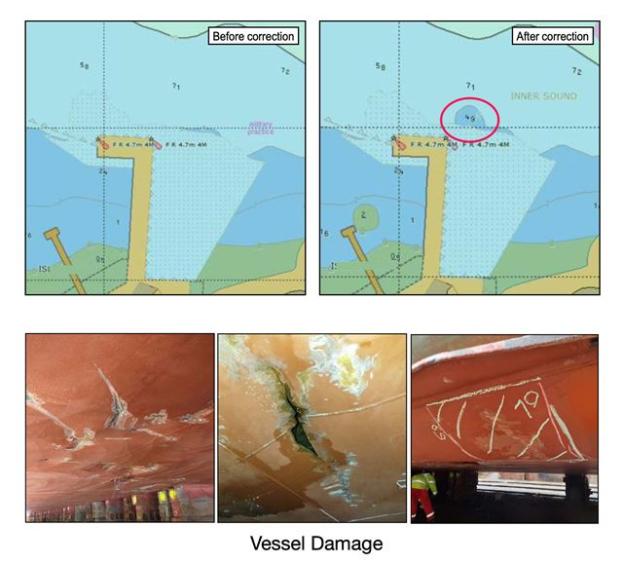202221 Tanker hits charted shoal while approaching berth
As edited from MAIB (UK) report 15/2021
A chemical carrier was inbound for a port in good visibility and weather conditions. This was the first time the Master and OOW had entered this particular port.
In preparing the passage plan, slack water had been chosen as a time best suited to berth as the tidal stream would be minimal. Low water was predicted to be at 1515 with a height of 1.1 metres, and the plan was to arrive around this time. The next daylight slack water was just over 19 hours later at high tide with a height of 4.7 metres.
In the final approach, the OOW advised the Master of a 4.9 metre charted depth just north of the pier. Since the state of the tide was low at 1.1 metre and the vessel was drawing 6.2 metres aft, this meant they would touch bottom if they passed over this charted depth. The Master responded that the echo sounder was reading 7.0 metres of water so he was content to proceed with the berthing. As the vessel approached, now 50 metres north of the pier, there was a sudden shudder throughout the ship. The bow swung to the south and the vessel came to a stop. After several attempts to clear the vessel the Master succeeded and, with the now rising tide, they berthed under their own power.
It was found that No.5 main ballast tank was experiencing an ingress of water, so the ballast pumps were started to control the flooding.
The investigation found that the 4.9m charted depth, 50m north of the pier, was brought to the attention of the Master while preparing the passage plan. Such a shoal would prevent the vessel from safely berthing at low water. The ECDIS ENC data was compared with the local survey chart and a photocopy extract of the Admiralty chart provided by the agent, neither of which showed the 4.9m feature. Reasoning that latter data was more recent, the Master directed the passage plan to be completed ignoring the 4.9m charted depth on the ENC.
As it transpired, neither the Master nor the officer had checked the update status of the ENC as part of the planning process. Both were unaware that the 4.9m obstruction was a recent correction dated only eight days before the grounding. It was, in the end, more recent and accurate than the agent's pre-arrival information.

Lessons learned
- The safest passage plan is one which relies on the most accurate and recent navigation data. Make sure to check yours.
- Entering a new port (for the bridge team) with known strong tidal currents, without pilotage and with critical under keel clearance is a scenario that calls for extra care. Even discounting the fact that the Master believed the 4.9m depth was outdated, entering at high tide slack water would be a better choice than low tide slack water.
Reader's comment
There has been several readers commenting on the ''Lesson learned'' from MARS report 2022005. These readers are not in agreement with establishing VHF contact with another vessel to vanquish any bad assumptions on the actions of the other vessel. The lesson learned was written as;
''When in doubt and always when a very small CPA is detected, establish communications with the other vessel and ensure everyone knows what actions are to be taken.''
The collision regulations are meant to be applied by all mariners and if applied correctly will normally result in good outcomes without VHF communication. However, there can be ambiguous situations or other instances where it is an added value to ensure you are not making a wrong assumption as to the actions of the other vessel. But, VHF communication should be done in good time and as a supplement to what the collision regulations require. Also, the word ''always'' as written in the lesson learned is too categorical and readers should note that we stand corrected on that point.
